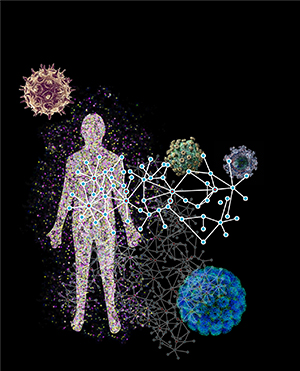
Researchers implement P-HIPSTer, an in silico computational framework that leverages protein structure information to identify approximately 282,000 protein-protein interactions across all fully-sequenced human-infecting viruses (1001 in all). This image highlights that in addition to rediscovering known biology, P-HIPSTer has yielded a series of new findings and enables discovery of a previously unappreciated universe of cellular circuits and biological principles that act on human-infecting viruses. (Image Courtesy of Dr. Sagi Shapira)
Researchers at Columbia University Irving Medical Center have leveraged a computational method to map protein-protein interactions between all known human-infecting viruses and the cells they infect. The method, along with the data that it generated, has spawned a wealth of information toward improving our understanding of how viruses manipulate the cells that they infect and cause disease. Among its findings, the work uncovered a role for estrogen receptor in regulating Zika Virus (ZIKV) infection, as well as links between cancer and the human papillomavirus (HPV).
The research, led by Sagi Shapira , PhD, Assistant Professor in the Department of Systems Biology and the Department of Microbiology & Immunology at Columbia University Vagelos College of Physicians and Surgeons , appears today in the journal, Cell . Dr. Shapira’s collaborators include Professors Barry Honig , PhD, of Systems Biology and of Biochemistry and Molecular Biophysics and Raul Rabadan , PhD, of Systems Biology and of Biomedical Informatics.